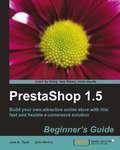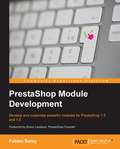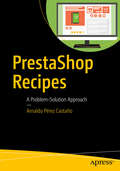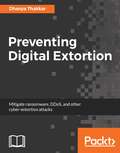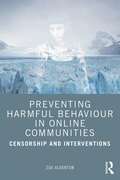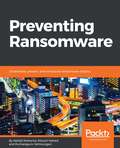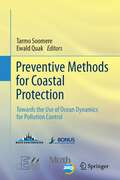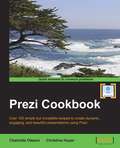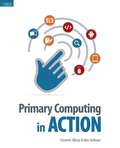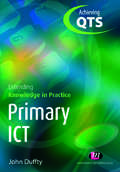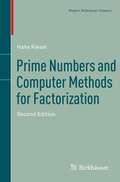- Table View
- List View
PrestaShop 1.5 Beginner’s Guide
by John Horton Jose A. TizonThis book is written in a friendly voice with lots of tips, tricks, and screenshots to help you set up, extend, and personalize your own online shop. If you want to start your own e-commerce business, then this book will help you do that.This book is for people who are interested in creating an online shop. Basic HTML and CSS skills would be beneficial but are not required as we will provide you with all the code and know-how you need.
PrestaShop Module Development
by Fabien SernyIf you are a developer who is new to PrestaShop and wants to get a good foundation in development on the PrestaShop framework, this book is for you. It's assumed that you will have some experience with PHP5, jQuery, and HTML/CSS (no need to be an expert on it).
PrestaShop Recipes
by Arnaldo Pérez CastañoCustomize all your PrestaShop themes with easy-to-follow recipes designed to remedy common pitfalls. Separated clearly into subjects, you will easily be able to look up the problem you are having and find a solution. Free of jargon and long sections of theory, PrestaShop Recipes enables you to troubleshoot and learn all at the same time. This book will aid you in your PrestaShop development – the free, open source e-commerce content management solution written in PHP and with support for MySQL. Accessible to small start-ups or larger businesses, it is becoming a very popular eCommerce solution and this book will enable you to use it to its full potential.
Presto Sketching: The Magic of Simple Drawing for Brilliant Product Thinking and Design
by Ben CrothersDo you feel like your thoughts, ideas, and plans are being suffocated by a constant onslaught of information? Do you want to get those great ideas out of your head, onto the whiteboard and into everyone else’s heads, but find it hard to start? No matter what level of sketching you think you have, Presto Sketching will help you lift your game in visual thinking and visual communication.In this practical workbook, Ben Crothers provides loads of tips, templates, and exercises that help you develop your visual vocabulary and sketching skills to clearly express and communicate your ideas. Learn techniques like product sketching, storyboarding, journey mapping, and conceptual illustration. Dive into how to use a visual metaphor (with a library of 101 visual metaphors), as well as tips for capturing and sharing your sketches digitally, and developing your own style.Designers, product managers, trainers, and entrepreneurs will learn better ways to explore problems, explain concepts, and come up with well-defined ideas - and have fun doing it.
Preventing Bluetooth and Wireless Attacks in IoMT Healthcare Systems
by John ChirilloA timely technical guide to securing network-connected medical devices In Preventing Bluetooth and Wireless Attacks in IoMT Healthcare Systems, Principal Security Architect for Connection, John Chirillo, delivers a robust and up-to-date discussion of securing network-connected medical devices. The author walks you through available attack vectors, detection and prevention strategies, probable future trends, emerging threats, and legal, regulatory, and ethical considerations that will frequently arise for practitioners working in the area. Following an introduction to the field of Internet of Medical Things devices and their recent evolution, the book provides a detailed and technical series of discussions—including common real-world scenarios, examples, and case studies—on how to prevent both common and unusual attacks against these devices. Inside the book: Techniques for using recently created tools, including new encryption methods and artificial intelligence, to safeguard healthcare technology Explorations of how the rise of quantum computing, 5G, and other new or emerging technology might impact medical device security Examinations of sophisticated techniques used by bad actors to exploit vulnerabilities on Bluetooth and other wireless networks Perfect for cybersecurity professionals, IT specialists in healthcare environments, and IT, cybersecurity, or medical researchers with an interest in protecting sensitive personal data and critical medical infrastructure, Preventing Bluetooth and Wireless Attacks in IoMT Healthcare Systems is a timely and comprehensive guide to securing medical devices.
Preventing Digital Extortion
by Dhanya ThakkarLearn the art of preventing digital extortion and securing confidential data About This Book • Get acquainted with multiple cyber extortion attacks and techniques to mitigate them • Learn how DDOS, Crypto Virus, and other cyber extortion techniques can infect your computers, smartphones, servers, and cloud • A concise, fast-paced guide that develops your skills in protecting confidential data by leveraging widely used tools Who This Book Is For This book targets IT security managers, IT security engineers, security analysts, and professionals who are eager to avoid digital extortion for themselves or their organizations. They may have heard of such attacks but are not aware of their various types, techniques, and business impact. What You Will Learn • Delve into the various types, stages, and economics of digital extortion • Understand the science behind different attacks • Understand the gravity of and mechanics behind ransomware and prevent and mitigate data breaches and financial losses • Use effective tools to defend against ransomware • Analyze attacks, the money flow, and cyber insurance processes • Learn the art of preventing digital extortion and securing confidential data • Get an idea of the future of extortion tactics and how technological advances will affect their development In Detail More and more cyber threats keep emerging every day, affecting organizations across the board, targeting the entire spectrum of the Internet. Digital--or cyber--extortion so far has come across as the most serious of such threats as it seeks to profit from criminal activity, akin to blackmail. Such extortion has been rising exponentially in the digital age and has become a huge illegal money-making business, affecting users and organizations ranging from small businesses to large enterprises. This is an insightful study spelling out in detail the ways and means employed by cyber criminals in targeting various devices and the multiple dangers such malicious activity embodies. Here will be found an overview of methods employed to impact and infect computers, smartphones, servers, and the IoT for cyber extortion. Then, it will move on to specific subjects in more detail, covering attacks such as DDoS-based extortion, cryptoviruses, and ransomware. You will learn how to prevent such attacks and eliminate them if you are compromised. This book will help you become a pro at securing your data and preventing your organization from paying a hefty ransom. Style and approach This step-by-step guide will start with the fundamentals of digital or cyber extortion and the various techniques used by hackers to demand ransom from an organization. It also focuses on types of ransomware and how it can infect your computer, mobile, cloud, server, and IOT. This practical guide will also explain how you can eliminate such attacks by leveraging various open source/commercial tools.
Preventing Harmful Behaviour in Online Communities: Censorship and Interventions
by Zoe AldertonPreventing Harmful Behaviour in Online Communities explores the ethics and logistics of censoring problematic communications online that might encourage a person to engage in harmful behaviour. Using an approach based on theories of digital rhetoric and close primary source analysis, Zoe Alderton draws on group dynamics research in relation to the way in which some online communities foster negative and destructive ideas, encouraging community members to engage in practices including self-harm, disordered eating, and suicide. This book offers insight into the dangerous gap between the clinical community and caregivers versus the pro-anorexia and pro-self-harm communities – allowing caregivers or medical professionals to understand hidden online communities young people in their care may be part of. It delves into the often-unanticipated needs of those who band together to resist the healthcare community, suggesting practical ways to address their concerns and encourage healing. Chapters investigate the alarming ease with which ideas of self-harm can infect people through personal contact, community unease, or even fiction and song and the potential of the internet to transmit self-harmful ideas across countries and even periods of time. The book also outlines the real nature of harm-based communities online, examining both their appeal and dangers, while also examining self-censorship and intervention methods for dealing with harmful content online. Rather than pointing to punishment or censorship as best practice, the book offers constructive guidelines that outline a more holistic approach based on the validity of expressing negative mood and the creation of safe peer support networks, making it ideal reading for professionals protecting vulnerable people, as well as students and academics in psychology, mental health, and social care.
Preventing Ransomware: Understand, prevent, and remediate ransomware attacks
by Abhijit Mohanta Kumaraguru Velmurugan Mounir HahadYour one-stop guide to know digital extortion and it's prevention.Key FeaturesA complete guide to how ransomware worksBuild a security mechanism to prevent digital extortion.A practical approach to knowing about, and responding to, ransomware.Book DescriptionRansomware has turned out to be the most aggressive malware and has affected numerous organizations in the recent past. The current need is to have a defensive mechanism in place for workstations and servers under one organization.This book starts by explaining the basics of malware, specifically ransomware. The book provides some quick tips on malware analysis and how you can identify different kinds of malware. We will also take a look at different types of ransomware, and how it reaches your system, spreads in your organization, and hijacks your computer. We will then move on to how the ransom is paid and the negative effects of doing so. You will learn how to respond quickly to ransomware attacks and how to protect yourself. The book gives a brief overview of the internals of security software and Windows features that can be helpful in ransomware prevention for administrators. You will also look at practical use cases in each stage of the ransomware phenomenon. The book talks in detail about the latest ransomware attacks involving WannaCry, Petya, and BadRabbit.By the end of this book, you will have end-to-end knowledge of the trending malware in the tech industry at present.What you will learn Understand malware types and malware techniques with examples Obtain a quick malware analysis Understand ransomware techniques, their distribution, and their payment mechanism Case studies of famous ransomware attacks Discover detection technologies for complex malware and ransomware Configure security software to protect against ransomware Handle ransomware infectionsWho this book is forThis book is targeted towards security administrator, security analysts, or any stakeholders in the security sector who want to learn about the most trending malware in the current market: ransomware.
Preventive Biomechanics
by Christophe Then Gerhard SilberHow can we optimize a bedridden patient's mattress? How can we make a passenger seat on a long distance flight or ride more comfortable? What qualities should a runner's shoes have? To objectively address such questions using engineering and scientific methods, adequate virtual human body models for use in computer simulation of loading scenarios are required. The authors have developed a novel method incorporating subject studies, magnetic resonance imaging, 3D-CAD-reconstruction, continuum mechanics, material theory and the finite element method. The focus is laid upon the mechanical in vivo-characterization of human soft tissue, which is indispensable for simulating its mechanical interaction with, for example, medical bedding or automotive and airplane seating systems. Using the examples of arbitrary body support systems, the presented approach provides visual insight into simulated internal mechanical body tissue stress and strain, with the goal of biomechanical optimization of body support systems. This book is intended for engineers, manufacturers and physicians and also provides students with guidance in solving problems related to support system optimization.
Preventive Methods for Coastal Protection: Towards the Use of Ocean Dynamics for Pollution Control
by Ewald Quak Tarmo SoomereThe aim of the book is to present for non-specialist researchers as well as for experts a comprehensive overview of the background, key ideas, basic methods, implementation details and a selection of solutions offered by a novel technology for the optimisation of the location of dangerous offshore activities in terms of environmental criteria, as developed in the course of the BalticWay project. The book consists of two parts. The first part introduces the basic principles of ocean modeling and depicts the long way from the generic principles to the practical modeling of oil spills and of the propagation of other adverse impacts. The second part focuses on the techniques for solving the inverse problem of the quantification of offshore areas with respect to their potential to serve as a source of environmental danger to vulnerable regions (such as spawning, nursing or also tourist areas). The chapters are written in a tutorial style; they are mostly self-contained and understandable for non-specialist researchers and students. They are carefully peer-reviewed by international experts. The goal was to produce a book that highlights all key steps, methods, models and data sets it is necessary to combine in order to produce a practically usable technology and/or decision support system for a particular sea region. Thus the book is useful not only as a description and a manual of this particular technology but also as a roadmap highlighting the complicated technical issues of ocean modeling for practical purposes. It describes the approaches taken by the authors in an understandable way and thus is useful for educational purposes, such as a course in industrially and environmentally relevant applications of ocean modeling.
Prezi Cookbook
by Christina Hoyer Charlotte OlssonThis book is intended for both beginners who want to get started with Prezi as well as experienced users who want to enhance their knowledge of Prezi. If you are a seasoned presenter, you can use this book to quickly transfer your presentation skills to Prezi. If you are new to presenting, the guidelines and tips in this book take you by the hand and guide you to complete mastery of Prezi.
Prezi Essentials
by Domi SinclairIf you want to learn Prezi, and specifically design within Prezi, this is the book for you. Perhaps you already know a bit about Prezi but have never used it, or perhaps you have used Prezi before but want to learn how to incorporate your own custom design elements. In either case, this book will get you up and running quickly. It would be helpful to have a bit of familiarity with basic design concepts and the use of Prezi, but prior experience is not essential.
Prezi For Dummies
by Stephanie DiamondA one-stop resource for an exciting new Web-based, slide-free presentation tool! People who have been seeking a flashier version of PowerPoint have found it-and it's Prezi. A Web-based, slide-free presentation tool, Prezi allows users to create and give rich, Web-based presentations complete with dynamic content, contextual layouts, and eye-catching visuals. Prezi For Dummies gets you rapidly up to speed, including how to think outside the traditional slide, create your project, insert Flash and other graphic files, and publish your presentation to a public domain. You'll also learn valuable tips on what makes a good Prezi. Introduces Prezi, a Web-based, Flash-friendly, dynamic presentation tool Explains how to use online and offline editors and insert images, video, sound, Flash files, and other complex graphics Covers presenting a Prezi, publishing it to a public domain, and collaborating with others Offers tips and insights on what makes a good Prezi-and how to think visually to create content that benefits your business or organization Move beyond slides, put your visual thinking cap on, and get the very most of Prezi with this timely, practical guide.
Prezi HOTSHOT
by Hedwyg Van GroenendaalThis book takes a hands-on, tutorial-style approach that walks you through ten individual projects, each focusing on producing a specific Prezi. If you have some basic experience of Prezi and want to gain advanced knowledge by building different kinds of Prezi projects, then this book is for you.
Pricing Models of Volatility Products and Exotic Variance Derivatives (Chapman and Hall/CRC Financial Mathematics Series)
by Yue Kuen Kwok Wendong ZhengPricing Models of Volatility Products and Exotic Variance Derivatives summarizes most of the recent research results in pricing models of derivatives on discrete realized variance and VIX. The book begins with the presentation of volatility trading and uses of variance derivatives. It then moves on to discuss the robust replication strategy of variance swaps using portfolio of options, which is one of the major milestones in pricing theory of variance derivatives. The replication procedure provides the theoretical foundation of the construction of VIX. This book provides sound arguments for formulating the pricing models of variance derivatives and establishes formal proofs of various technical results. Illustrative numerical examples are included to show accuracy and effectiveness of analytic and approximation methods. Features Useful for practitioners and quants in the financial industry who need to make choices between various pricing models of variance derivatives Fabulous resource for researchers interested in pricing and hedging issues of variance derivatives and VIX products Can be used as a university textbook in a topic course on pricing variance derivatives
Pricing Your Portraits
by Jeff SmithPortrait photographers agree that one of the most important yet shrouded aspects of running a successful business is accurately pricing your products for profit. Some charge too little, then scramble to photograph and edit photos for throngs of clients, only to become overwhelmed and burn out. Others price too low initially, just to get people in the door, but soon mark up their prices and lose clients to new photographers who charge rock-bottom prices. There are still others who price themselves out of the game right out of the gate.Jeff Smith, owner of two thriving portrait studios teaches you how to tackle one of photography's most vexing problems-working out a pricing structure that allows you to cover your costs and clear a profit that you can live comfortably with. Smith begins by showing you methods that he-and countless other pros-have used in a misguided attempt to reap a great cash flow, helping you avoid time-and-revenue-burning missteps. Next, he walks you through the process of figuring out where your money goes-How much should you shell out for new equipment? What falls into the category of "overhead?" How much do you need to pay your staff and yourself?-and then moves on to show ways to cut costs, price individual prints and packages, maintain your desired business volume, retain existing clients, and delegate tasks in order to work smartly toward profitability-all while enjoying your work and achieving professional and creative satisfaction.
Pricing, Online Marketing Behavior, and Analytics
by Giampaolo VigliaBehavioral Pricing, Online Marketing Behavior, and Analytics covers many different aspects of how online marketing works and its continuous evolution.
Pride Before the Fall: The Trials of Bill Gates and the End of the Microsoft Era
by John HeilemannPride Before the Fall is the definitive account of the trial that shook an economy: United States v. Microsoft. Award-winning journalist John Heilemann uncovers the explosive truth behind the headlines: how the high-tech kingpins Bill Gates had tried to destroy, together with a motley crew of anonymous crusaders, worked in secret to help the government take down the most powerful empire of the information age. As colorful and riveting as a detective novel, Pride Before the Fall is an unforgettable tale of human ambition and human frailty - a timely saga of arrogance, hubris, ruthlessness, and revenge.e
Pride and Prejudice on Social Media
by Sarah Day Claire McGowanElizabeth Bennet has politely declined your friend request and asks that you do not slide into her DMs again. It is a truth universally acknowledged, that a single man in possession of a good fortune, will probably be verified on social media. The characters of Pride and Prejudice are navigating the same struggles on unfamiliar channels - social media channels, to be precise. When authors Claire McGowan and Sarah Day imagined how 'Pride and Prejudice on Social Media' might look, retelling the story through mocked-up social media posts, their post instantly went viral. Have you ever wondered what Austen's most famous couple might be like if it played out online? Well, here is the story in full . . .Perfect for fans of Elizabeth Bennet and Mr Darcy . . .
Pride and Prejudice on Social Media: The perfect gift for fans of Jane Austen
by Sarah Day Claire McGowanElizabeth Bennet has politely declined your friend request and asks that you do not slide into her DMs again. It is a truth universally acknowledged, that a single man in possession of a good fortune, will probably be verified on social media. The characters of Pride and Prejudice are navigating the same struggles on unfamiliar channels - social media channels, to be precise. When authors Claire McGowan and Sarah Day imagined how 'Pride and Prejudice on Social Media' might look, retelling the story through mocked-up social media posts, their post instantly went viral. Have you ever wondered what Austen's most famous couple might be like if it played out online? Well, here is the story in full . . .Perfect for fans of Elizabeth Bennet and Mr Darcy . . .(P) 2021 Hodder & Stoughton Limited
Primary Computing in Action
by Ben Sedman Yasemin AllsopPresenting practical ideas that support teachers and trainees with the planning, implementation and assessment of the 2014 Primary Computing Curriculum. Demonstrating how freely available apps and web-based applications, programmes for PCs and Macs, can be used creatively to design innovative and engaging activities in the Early Years, Key Stages 1 and 2. Covering all aspects of the 2014 primary curriculum, including computer science, digital literacy and information technology. Includes both plugged and unplugged activities.
Primary Computing in Action
by Ben Sedman Yasemin AllsopPresenting practical ideas that support teachers and trainees with the planning, implementation and assessment of the 2014 Primary Computing Curriculum. Demonstrating how freely available apps and web-based applications, programmes for PCs and Macs, can be used creatively to design innovative and engaging activities in the Early Years, Key Stages 1 and 2. Covering all aspects of the 2014 primary curriculum, including computer science, digital literacy and information technology. Includes both plugged and unplugged activities.
Primary ICT Knowledge, Understanding and Practice
by Edward WinklemanThis second edition of a highly successful course book is written specifically to help British trainee primary teachers develop a secure knowledge and understanding of the ways in which ICT supports teaching and learning. It identifies clear links with the new Standards for the award of Qualified Teacher Status, with the National Curriculum, and with the exemplar Scheme of Work for ICT at Key Stages 1 and 2. Each chapter includes links with recent and relevant research as well as directed activities providing a focus for further reading, observation, practice, evaluation and reflection.
Primary ICT: Extending Knowledge In Practice (Achieving QTS Extending Knowledge in Practice LM Series)
by John DufftyStill the biggest concern for many on initial teacher training courses is the acquisition of subject knowledge and the ability to translate that into effective teaching. This book addresses this - building on the core subject knowledge covered in the Achieving QTS series and relating it to classroom practice. It supports trainees in extending and deepening their knowledge of ICT and demonstrating how to apply it to planning and implementing lessons. Practical and up-to-date teaching examples are used to clearly contextualize subject knowledge. A clear focus on classroom practice helps trainees to build confidence and develop their own teaching strategies.
Prime Numbers and Computer Methods for Factorization
by Hans RieselFrom the original hard cover edition: In the modern age of almost universal computer usage, practically every individual in a technologically developed society has routine access to the most up-to-date cryptographic technology that exists, the so-called RSA public-key cryptosystem. A major component of this system is the factorization of large numbers into their primes. Thus an ancient number-theory concept now plays a crucial role in communication among millions of people who may have little or no knowledge of even elementary mathematics. Hans Riesel's highly successful first edition of this book has now been enlarged and updated with the goal of satisfying the needs of researchers, students, practitioners of cryptography, and non-scientific readers with a mathematical inclination. It includes important advances in computational prime number theory and in factorization as well as re-computed and enlarged tables, accompanied by new tables reflecting current research by both the author and his coworkers and by independent researchers. The book treats four fundamental problems: the number of primes below a given limit, the approximate number of primes, the recognition of primes and the factorization of large numbers. The author provides explicit algorithms and computer programs, and has attempted to discuss as many of the classically important results as possible, as well as the most recent discoveries. The programs include are written in PASCAL to allow readers to translate the programs into the language of their own computers. The independent structure of each chapter of the book makes it highly readable for a wide variety of mathematicians, students of applied number theory, and others interested in both study and research in number theory and cryptography.
